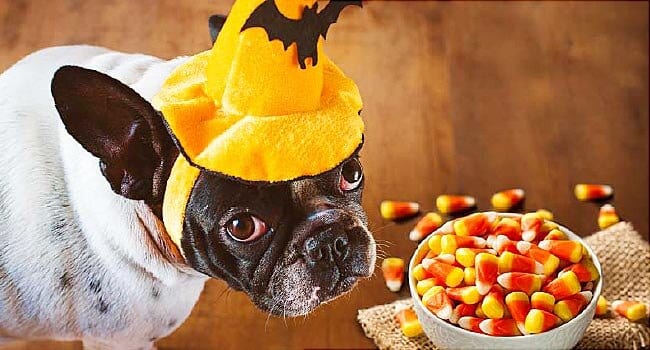By Matthew Kearns, DVM
 I thought it a good time to recycle an article that is appropriate for this time of year. Here are a few tips to make sure this and every Halloween is a safe and happy one.
I thought it a good time to recycle an article that is appropriate for this time of year. Here are a few tips to make sure this and every Halloween is a safe and happy one.
Candy and chocolate poisoning
Chocolate is dangerous for two reasons. The first is that it contains two chemicals — caffeine and theobromine, which are stimulants in the methylxanthine class. White chocolate contains almost none of these compounds and baking chocolate has the highest concentrations.
Symptoms begin within 6 to 12 hours after ingestion and include panting, hyperactivity, increased thirst and urination. High concentrations lead to irregular heart rhythms, seizures, coma and death. There are specific toxic levels for all pets but, just like people, some dogs and cats can be very sensitive to chocolate and show signs of poisoning from much lesser amounts.
Chocolate is also very high in sugar and fat. Minimally this could cause some mild diarrhea, but I have personally seen a few cases of serious gastroenteritis, pancreatitis and liver disease from ingestion of large amounts of chocolate and other candy.
Unfortunately, dogs and cats (especially young ones) will be more interested in eating their costume than wearing it. I have both experienced, as well as heard from colleagues, stories of pulling out portions of a witch’s nose, small scarecrow teddy bears, etc. The wrappers from candy can sometimes get wadded up in the stomach or small intestines and either cause intense pain or unavoidable (and expensive) surgery. Corn cobs used as decorations should also be out of reach of curious (and hungry pets). As much as you want the house to look festival, make sure to keep all holiday items out of reach of pets.
Fears and phobias
Talk to your veterinarian if your pet is afraid of loud noises or large numbers of people coming to the door. Many times a calming supplement or mild tranquilizer sedative is all that is needed to get through Halloween, but always have your pet examined by the veterinarian (especially older pets) before administering these medications. Tranquilizers will cause a drop in blood pressure, which in healthy pets is not a problem but in older or diseased pets can be dangerous (even life-threatening in some cases).
Malicious injuries
Be aware (especially with cats that go outside) that they are in for the night early. Unfortunately, we do see malicious acts toward animals increase on this particular holiday.
I hope this information is helpful in providing a safe Halloween environment for our pets.
Dr. Kearns practices veterinary medicine from his Port Jefferson office and is pictured with his son Matthew and his dog Jasmine.



 This year more than ever I consider my pet my best friend and most loyal companion. I love that social distancing is not necessary when we get together. Therefore, I always want to make sure everything we do is safe and there are some things to look out for in the fall. Here is a list of common hazards to avoid:
This year more than ever I consider my pet my best friend and most loyal companion. I love that social distancing is not necessary when we get together. Therefore, I always want to make sure everything we do is safe and there are some things to look out for in the fall. Here is a list of common hazards to avoid:
 I thought it a good time to recycle an article that is appropriate for this time of year. Here are a few tips to make sure this and every Halloween is a safe and happy one.
I thought it a good time to recycle an article that is appropriate for this time of year. Here are a few tips to make sure this and every Halloween is a safe and happy one.


